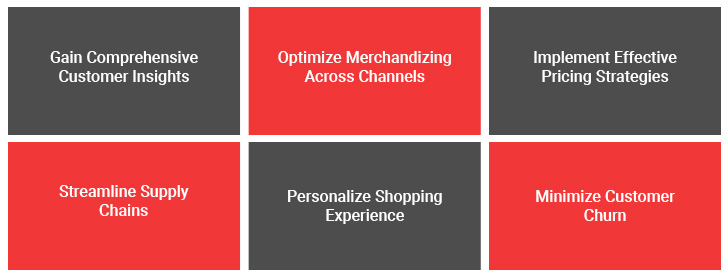In light of the seismic shifts the retail industry has undergone in the last decade, retail companies are pushed to accelerate their digital transformation efforts and embrace innovative business models. Data analytics, with its ability to offer actionable, future-focussed insights, has become an indispensable tool retail companies need to have in their arsenal to stay competitive in a volatile marketplace.

Thanks to analytics, retailers can now make decisions on crucial aspects of their business-promotion, supply chain, or pricing-with more clarity. No wonder, the demand for analytics in retail is growing. According to recent projections by Fortune Business Insights, the global retail analytics market size is expected to touch $18.33 billion by 2028. Retailers that aspire to become future-ready and stay resilient in the face of constant change need to integrate analytics across their operations.
In this blog, we will explore 6 ways in which data analytics is shaping the retail industry and helping retailers tap opportunities for growth.

1. Gain Comprehensive Customer Insights
Consider all the data retailers acquire from daily interactions with customers: their transaction history, demographic information, and loyalty status. To generate in-depth customer insights that inform revenue-optimizing decisions, this data needs to be enriched from both internal and external sources. These data sets also need to be integrated and analyzed to get actionable, comprehensive customer insights. And that’s where analytics comes into the picture.
Analytics software with advanced machine learning capabilities helps retailers fulfill these needs. Thanks to these tools, retailers can access several relevant statistics in addition to basic customer data including their customers’ online behavior, purchasing patterns, and mobility data from smartphone shoppers. These data points can be consolidated and processed to generate in-depth customer insights and predict their future buying behavior.
For instance, a local retailer can count on analytics to study customer characteristics in their immediate vicinity. Using the right tools, the retailer can glean granular data on advanced consumer demographics, psychographics, in-store footfall, competitor stores, and cross-shopping patterns to understand what drives consumption in their surroundings. In other words, data analytics equips retail businesses with crucial knowledge they can leverage to make data-driven decisions and boost customer satisfaction levels.
2. Optimize Merchandizing Across Channels
In the past, merchandising was limited to brick-and-mortar stores. However, with the rise of e-commerce and mobile shopping, it’s crucial to ensure consistency across all customer touchpoints. This can be done by unifying various consumer channels and creating an effective omnichannel approach integrated with the business strategy. Thanks to sophisticated analytics software and IoT, retailers can make this possible.
Through analytics, retail players can consolidate data across all customer touchpoints and formulate an overarching strategy that seamlessly merges the requirements of both offline and online worlds. This allows retailers to stay agile and flexible in the face of ever-evolving customer demands.
Analytics also enables retail businesses to gain a bird’s-eye view of the processes involved in marketing, production, and supply. They can leverage this knowledge to streamline supply chains, fine-tune assortment planning, refine pricing and promotion strategies, and respond proactively to upcoming trends.
Retail behemoths including Starbucks and Apple have effectively employed big data to build an efficient global supply chain and meet the demands of customers across online and offline channels.
3. Implement Effective Pricing Strategies
A business’s success can hinge on its pricing strategies. While setting the right prices can result in a substantial increase in revenue, even the slightest miscalculation can lead to a catastrophic outcome.
When formulating pricing strategies, retailers have to take a range of factors into account, including demand, seasonal sales, inventory levels, and competitor pricing. These companies also need to navigate cross-channel pricing, dynamic pricing approaches, and personalized offers. Big data analytics can help retailers integrate these variables to create scientifically sound and predictive pricing strategies that can be implemented across different platforms.
E-commerce companies, for instance, employ dynamic pricing strategies to stay ahead of the competition and generate higher earnings. They leverage predictive analytics tools that analyze competitor pricing, seasonality, market trends, and several other factors to determine the highest price customers are willing to pay for a particular product. All in all, analytics is enabling retailers to implement effective pricing models that attract customers and maximize profit margins.
Solve Your Toughest Challenges With Predictive Analytics
4. Streamline Supply Chains
Ensuring an efficient supply chain is crucial for profitable retail operations. To achieve this, retailers need to align their supply and distribution with customer demand. Predictive analytics can play a vital role in optimizing supply and demand planning. AI-ML algorithms can analyze patterns in sales, customer preferences, and shipments and combine these with external data to forecast demand using predictive modeling and scenario planning.
By accurately predicting demand, retailers can gain a better understanding of the demand-supply dynamics and optimize inventory management. They can reduce the stock of low-demand items and avoid stockouts for high-demand items. Predictive analytics also helps retailers anticipate shifts in the marketplace and predict how high-demand periods (e.g. holiday season) may impact customer choices. This way, they can adjust supply and distribution to maximize earnings during such times.
Analytics-powered demand forecasting can also have a significant impact at the manufacturing level. By accurately predicting requirements for various distribution channels, businesses can cut down on surplus production and minimize wastage. This not only saves costs but also contributes to a business’s sustainability efforts, making it a win-win situation.
5. Personalize Shopping Experience
Consumers in this day and age seek personalized shopping experiences that cater to their unique demands and choices. A recent study by Epsilon indicates that brands that offer personalized experiences are more likely to attract and retain customers. To capitalize on this trend, retailers need to devise strategies to create curated shopping experiences and provide personalized recommendations at scale. And that’s where machine learning plays a vital role.
Machine learning-based analytical solutions process large swathes of data including available product stock, customer browsing patterns, transactional history, and past behavior to generate differentiated offerings for each customer. These can be in the form of product recommendations, discounts, or loyalty programs. Such an approach not only increases opportunities for upselling and cross-selling but also drives customer engagement.
Uncover the Latest Trends in Data Analytics and BI
6. Minimize Customer Churn
One of the key priorities for any retail company in this fiercely competitive age is to foster customer loyalty. This is because the cost of attracting a new customer is more than six times that of retaining an existing one. Often when customers don’t get what exactly they expect from a brand, they may start looking for alternatives. By utilizing big data analytics, retailers can gain insights into factors that contribute to customer churn, allowing them to modify their offerings and prevent such scenarios.
For instance, after analyzing customer data following a monthly subscription, a retailer can use the insights gained to attract and retain subscribers who are more likely to become long-term customers. This would result in a significant drop in churn rate and enable the retailer to improve the lifetime value of a customer. This would also allow them to cut down on steep marketing expenses needed to acquire new customers.
Case in Focus
The client, a leading US-based office supplies manufacturer, was facing challenges with their existing analytics solution. As their business kept scaling, it was becoming more difficult for the company to analyze the ever-growing volumes of data scattered across multiple on-premise and cloud sources. The legacy approach to analytics resulted in error-prone manual work as well as data silos. Damco collaborated with the client to evaluate their business needs and developed a fully functional, scalable BI solution in just 4 months. The client was now able to access real-time insights from sales, marketing, and online channels on a unified dashboard, quickly identify gaps in business processes, and make faster, more accurate decisions, all while keeping a single source of truth. The BI solution has enabled the client to cut down their operational expenses by a whopping 33% and improve workplace productivity by nearly 3x.
The Final Word
With an increasing number of retailers leveraging data analytics to streamline operations and refine business strategies, the future of data analytics in retail looks promising. Needless to say, retailers who invest big time in analytics will be better positioned to stay ahead of the curve, increase profitability, and provide customers with personalized experiences.
Collaborating with a proven analytics expert like Damco can help retailers get the most out of their data, mitigate operational challenges, predict future trends, and gain data-driven customer insights for accelerated growth. To know more, connect with our tech experts today for a consultation.




